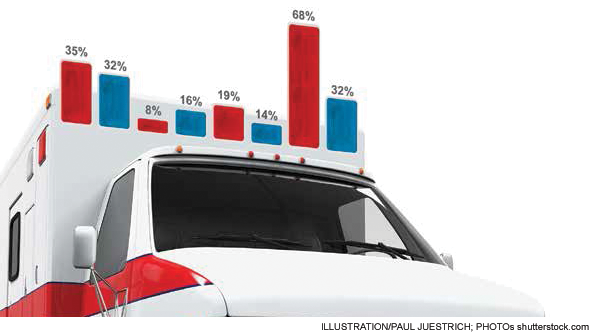
There is continuing growth in the percentage of overall hospital admissions presenting through the ED. The 2011 data survey finds that about 22 million admissions occurred through the ED. There were about 35 million hospital discharges, which included newborn infants from hospital delivery units. That means about 63 percent of inpatients were processed through the ED. The Emergency Department Benchmarking Alliance data survey finds an even higher number, with 68 percent of hospital inpatients arriving through the ED. The ED is clearly the “front door of the hospital.”
Explore This Issue
ACEP Now: Vol 34 – No 01– January 2015There is a long-term trend that American EDs are seeing between 2 and 3 percent more visits every year. More patients arrive with medical illnesses rather than injuries. More patients are elderly and arrive by emergency medical services.
The growing number of patients with primary mental health and substance abuse issues represents a serious challenge for emergency physicians.
It is clear that Americans have come to trust the quality of our service and the value for the time and money spent for their ED visits. Emergency physicians should continue to deliver services that provide a reliable and cost-effective system of unscheduled care.
 James J. Augustine, MD, FACEP, is director of clinical operations at EMP in Canton, Ohio; clinical associate professor of Emergency Medicine at Wright State University in Dayton, Ohio; vice president of the Emergency Department Benchmarking Alliance; and on the ACEP Board of Directors.
James J. Augustine, MD, FACEP, is director of clinical operations at EMP in Canton, Ohio; clinical associate professor of Emergency Medicine at Wright State University in Dayton, Ohio; vice president of the Emergency Department Benchmarking Alliance; and on the ACEP Board of Directors.
Pages: 1 2 | Single Page






One Response to “National Hospital Ambulatory Medical Care Survey Data Show Increase in Emergency Department Visits”
September 11, 2015
Using Electronic Medical Records to Predict Readmission Risk After Percutaneous Coronary Intervention - ACEP Now[…] characteristics derived from electronic medical records (EMR) can predict the risk of readmission after percutaneous coronary intervention (PCI), a study […]